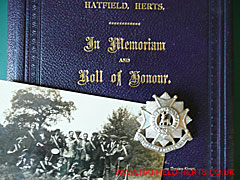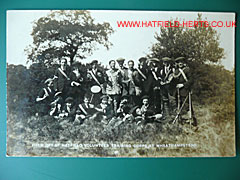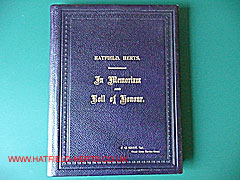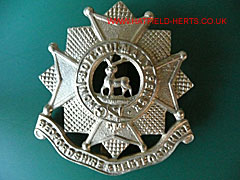 Hatfield
in World War I
Hatfield
in World War I
A secret weapon tested in tested in Hatfield during WWI heralded a revolution in warfare. The trials were attended by the top officers and political leaders of the British Armed Forces. The success of the initial trials led to a visit by King George V. However, while this literally earth-shaking new weapon changed the face of warfare forever, the real heroes were the people of the Parish of Hatfield who signed up in their hundreds to fight, and many died, in the Great War.
While Hatfield's military links and history dates back centuries, WWI innovations led to new and even more terrible forms of warfare. The scale of the slaughter is hard to understand. On one day, 1 July 1916, the British Army (including Empire troops) suffered 57,470 casualties. Even on 'quiet' days hundreds of soldiers, on both sides, lost their lives. The total number of lives lost is not known, and probably never will be (estimates vary wildly, the Encyclopaedia Britannica cites a figure of 8,500,000 soldiers and 13,000,000 civilian deaths – including from disease). Probably the only thing great about the Great War was the cost and suffering it caused.
Home Front
Tank
Hatfield is the place where the trials of the world's first operational tank were held during World War I. This prototype tank was built by William Foster & Company of Lincoln, and the two men most responsible for the design were William Tritton, managing director of the company, and Lieutenant W G Wilson, a naval officer who was later transferred to the Army with the rank of major. Both initially developed their own designs but it was Lieutenant Wilson who had the idea of having the tracks run right round the body of the tank (which was a rhomboid shape, pointed at the top in front and sloping at the back).
The first field trials were held at Hatfield on 29 January 1916. The prototype tank had been brought up by train and driven into Hatfield Park under cover of darkness. Initially called landships or landcruisers (at one stage the Royal Navy was leading on their development, thanks to the First Sea Lord of the Admiralty – at the time one Winston S Churchill, who knew about Afrikaaner armoured trains in the Boer War, and the success of Royal Navy Armoured Cars in Dunkirk in WWI), but this was felt to be too descriptive and risked letting the secret out. It was decided that the name had to be consistent with the covered shape of the vehicle while in transit. Cistern, Container and Reservoir were ultimately dropped in favour of the shorter, catchier but ambiguous name Tank.
The second series of trials at Hatfield were held on 2 February 1916. This time in front of several senior generals and political leaders. Among the distinguished audience was the next Prime Minister David Lloyd-George, former Prime Minister Arthur Balfour (nephew of the 3rd Marquess of Salisbury), and Lord Kitchener (whose finger-pointing image on the recruitment poster with the words 'Your Country Needs You' is one of the enduring images of WWI, and a design classic). However, while most were impressed, Lord Kitchener was not in favour of the new weapon.
On 8 February 1916, King George V came to Hatfield to see the new wonder weapon that was going to break the stalemate of trench warfare. Unlike Lord Kitchener, his majesty was reported to have been suitably impressed.
Last surviving Tank, Mark I (Male)
After the war, in 1919, in recognition of the use of his grounds (and presumably also his hospitality), Winston Churchill presented an example of a tank to the 4th Marquess of Salisbury. It was on display in the grounds of Hatfield House for many years, and many older residents recall playing in it during their childhood.
Eventually, exposed to the elements and vandalism, the tank fell into a state of disrepair. Corrosion led to one of the gun sponsons (essentially, a side-mounted gun turret) falling off.
The tank is the only known example of Mark I (Male). Part of a batch of 150 (75 Male and 75 Female – sex being determined by the weapons mounted on the tank); 23 built by William Foster & Company, and the rest by the Metropolitan Carriage Company. It has since been carefully restored and is now on display at the Tank Museum, Bovington.
Billets
A number of troops were billeted at Hatfield during the war (Hatfield Workhouse, demolished in 1989, was their main base). In late 1914, a Union Jack Club was opened for their use by the Governors of the Hatfield Gallery of Antiques. The troops were evidently well fed as a Hatfield food control inspector filed a report in August 1917 that a squad of soldiers had left 3lbs of bread in a field after a midday meal. Evidently this was considered such a serious issue that it was reported in The Times. Alternatively, it was carried to reassure parents that their offspring were being at least fattened before being sent to the slaughter.
Fund-raising
On 4 February 1915 a concert was held at Hatfield House to raise funds for the Hertfordshire Branch of the Incorporated Soldiers' and Sailors' Help Society. Artists appearing included Evangeline Florence, Gordon Cleather, Jean Sterling MacKinlay, with a recital from Henry Ainley.
Hospital
The cottage hospital near Northcutts (near the railway station, and now in use as a NHS Mental Health Clinic) was used as a Voluntary Aid Detachment (VAD) Hospital treating injured soldiers during the war. One casualty, Sergeant George Rice, is recorded as having died there in 1918 and was buried in St Luke's Churchyard.

Volunteer Training Corps and the Volunteer Force – Before Dad's Army
Undated postcard with the words 'Field day of the Hatfield Volunteer Training Corps at Wheathampsted' on the front. The Volunteer Training Corps and the Volunteer Force were established several years before the outbreak of WWI. Essentially, they were the Dad's Army (Home Guard or Local Defence Volunteers) of their day.
Men of Hatfield
As with the war as a whole, casualty figures for Hatfield are conflicting. The Hatfield town war memorial lists the names of 139 fatalities from the Parish of Hatfield. However, the Memorial and Roll of Honour book issued to the families of the fallen and returning servicemen lists 141 names. Unfortunately, there are more than just two discrepancies, and there is at least one casualty not listed in either of them.
There are several possible reasons for these variations – people who recently moved to or from the parish, poor handwriting, human errors, information coming to light after the book was issued, policy on recording deaths... Unfortunately, given the passage of time, it may need an examination of individual service records to clear things up but some are only accessible to authorities and family members. Attempts to clarify matters using the Commonwealth War Graves Commission (CWGC) database, 1911 Census records and information on headstones didn't always help. For example: John Hipgrave of the Bedfordshire Regiment, killed in 1914, is recorded on the Hatfield War Memorial as a Private, in the memorial book as a Lance-Corporal, and on the CWGC database as a Corporal. While it has been possible to cross-reference fatalities to some degree, information on survivors is almost entirely based on the memorial book. As a result, it is necessary to treat the information on individuals that follows with a degree of caution.

Memorial and Roll of Honour Book
The families of the fallen and returning servicemen in the Parish of Hatfield were given a copy of this 3-part book. The first part lists the names of those killed (141) in a dark blue font. Part two is 10-blank pages with a decorative green border for photographs and memoranda. The final part is the Roll of Honour that lists the names of all the men (726) of the parish who returned from the Great War. These pages have a decorative green border with the entries made with a dark brown font. The copy shown above belonged to one of the survivors (Sergeant E G Gray, Royal Army Service Corps – as embossed on the bottom right of the cover), and was sold at auction in 2008.
Navy
Men from Hatfield served in all branches of the British Armed Forces. While the majority served in the Army, around 45 are thought to have served with the Navy (not including 4 with the Royal Naval Air Service).
One of the naval recruits, Petty Officer Richard A May, is listed as having served with the Royal Navy (Armoured Car Squadron) – a unit whose success at Dunkirk is thought to have influenced Winston Churchill's support for developing the tank (5 other men from Hatfield are listed as serving in the Tank Corps – a branch of the Army).
Royal Flying Corps, Royal Air Force
The Royal Flying Corps (which 4 men from Hatfield served with), and the Royal Naval Air Service (another 4 men), were merged to form the Royal Air Force on 1 April 1918. A further 25 men from Hatfield Parish are listed as serving in the RAF (although some would almost certainly have had RFC or RNAS backgrounds).
One casualty not recorded on the Hatfield war memorial or memorial book (possibly as he was killed in a training accident and not in combat, or he may have been a temporary resident) is 2nd Lieutenant Walter Featherstone. An article in The Times (05.10.1917, page 5), revealed that he was aged 27, and a resident of North Lodge, Hatfield. He crashed during training and was "terribly burned", and later died at Eaton Square RFC Hospital.
The first man to fly an aeroplane over Hatfield (in 1911) went on to win the first Victoria Cross awarded to an airman in 1914.
Click here for the 'Rhodes-Moorhouse' aviation feature...
Army
 Bedfordshire
Regiment, Hertfordshire Regiment, and the Bedfordshire & Hertfordshire
Regiment
Bedfordshire
Regiment, Hertfordshire Regiment, and the Bedfordshire & Hertfordshire
Regiment
Not surprisingly, the majority of men from the Parish of Hatfield served in the Army.
The largest numbers served with the Bedfordshire Regiment (after the war in recognition of the number of men from Hertfordshire who had served and died it was renamed the Bedfordshire & Hertfordshire Regiment – the picture shows the cap badge), and the Hertfordshire Regiment. A much smaller number also served with the Hertfordshire Yeomanry.
The Bedfordshire Regiment was originally called Colonel Archibald Douglas's Regiment of the Foot when it was raised in 1688. Much later it incorporated the Hertfordshire Militia and Hertfordshire Volunteer Rifle Corps. In 1915 part of the Bedfordshire Regiment was split off to form the Hertfordshire Regiment.
Bedfordshire Regiment WWI battle honours include: Mons, Marne, Ypres, Loos, Somme, Arras, Cambrai, Suvla (Gallipoli theatre of war), Sambre, and Gaza.
A memorial and colours of the Bedfordshire Regiment can be found in St Etheldreda's Church, Hatfield. It is dedicated to Lieutenant-Colonel John Stanhope Collings-Wells VC DSO, the Officers, NCOs, and Men of the 4th Battalion, Bedfordshire Regiment. It was consecrated by Lord William Cecil, then Bishop of Exeter, in December 1920. The church also has a stained glass window commemorating the 3 (out of 4) sons of Lord William Cecil who were killed in action during WWI.
The men of Hatfield Parish also served with elite units like the Coldstream Guards, Grenadier Guards, Life Guards, Dragoon Guards, Honourable Artillery Company and Hussars. Others served with regiments the length and breadth of Great Britain. A few served with Canadian regiments (there are indications that some had Canadian nationality).
Statistics
Please note: these figures mainly rely on the Hatfield Parish Memorial book given to families of the fallen and returned servicemen (please see box above). Unfortunately, cross-referencing the fatalities section with the Hatfield town war memorial, and the Commonwealth War Graves Commission (CWGC) database shows a number of discrepancies between the data sets. Figures involving those that survived have not been cross-referenced so are unverified.
Fatalities: 139 (Hatfield War Memorial); 141 (Hatfield Memorial Book).
Served and survived: 726 (Hatfield Memorial Book).
Over 16 per cent of the men of Hatfield Parish who enlisted were killed during WWI.
NOTE (26.10.11): there are a number of Bedfordshire Regiment and Hertfordshire Regiment casualties listed in the 1921 Casualty Rolls not mentioned on the Hatfield War Memorial or Memorial Book, which only list Hatfield Parish casualties (and not Hatfield District).
Click here for the 'Lost Casualties' feature...
Number of officers: around 60 (including a Major-General, 2 Lieutenant-Colonels, 8 Majors and 18 Captains).
Number of NCOs: around 190 (including 84 Sergeants).
Decorations: 7 Distinguished Conduct Medals, 5 Military Crosses, 16 Military Medals,
1 Distinguished Service Medal, 2 Belgian and 1 French Croix de Guerre. Other
awards include a CMG, OBE and a Meritorious Service Medal.
[Please note: without accessing individual medal
citations or service records it is not possible to tell if any of these
decorations were awarded for pre-WWI campaigns. The OBE and CMG were
probably overall service awards. The MSM is a non-combat award]
Summary
The men of Hatfield Parish saw action with all the main branches of the British Armed Forces (including some exotic units like the Imperial Camel Corps). They fought and died in many of the main actions and battles of the First World War: Flanders, Hill 60, Gallipoli, Loos, Cambrai, Somme, Jutland, Thiepval, Ypres, Arras, Vimy Ridge...
Around 16 per cent of the men who left did not return alive. The number of wounded is unknown (information in obituaries show at least one officer had been wounded and either returned or had never left the front before he was killed a month later, while a surviving relative was wounded twice).
They paid a high price. It won't cost you anything to spend a moment or two thinking about their values and sacrifices.
Back to: Features on Hatfield14 September 2009